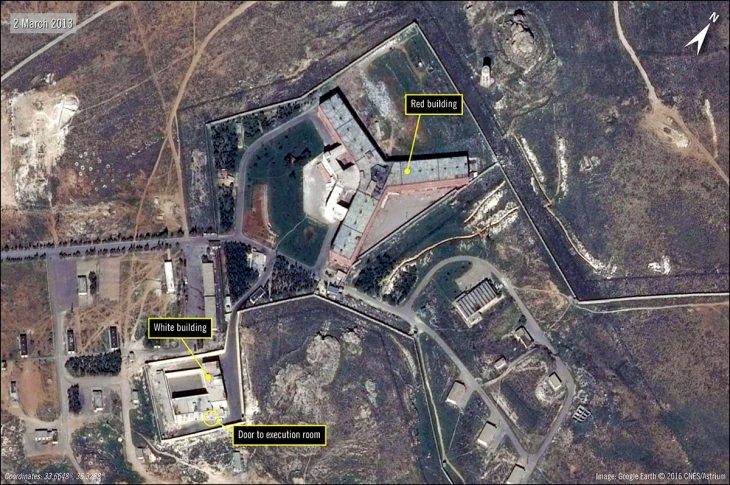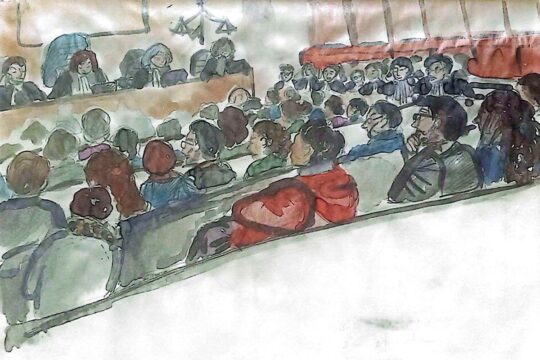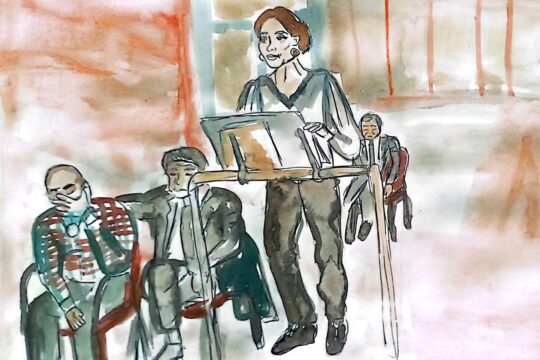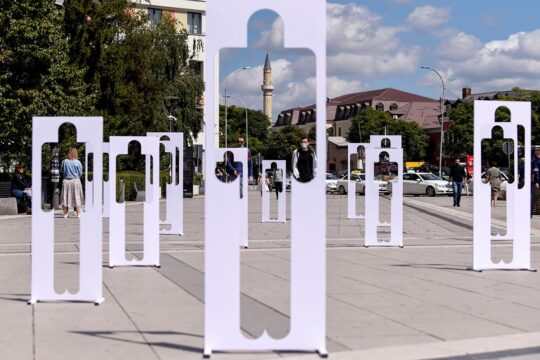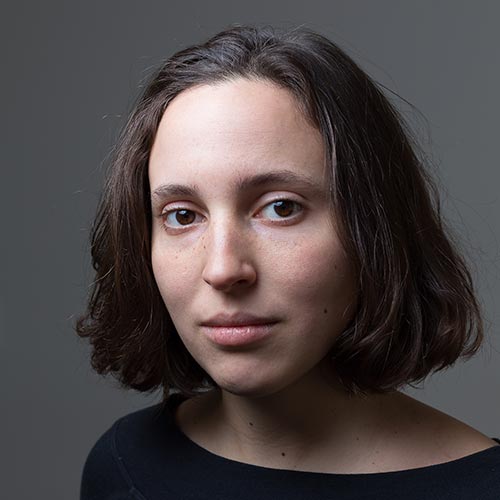After the trucks dumped the bodies into the ditches, the man drove back to his office in Damascus and opened a large notebook with neatly arranged lists. With the help of a security officer, he wrote down the number of corpses, and the names and numbers of the secret service branches they came from. He sent copies to his superiors and stored the notebook in a safe. Then he waited for the next delivery, which usually came at the crack of dawn, about four times per week. “The more bodies they brought, the more ditches they dug”, said the man, who testified last week in the Al-Khatib trial in Koblenz.
In the German city of Koblenz, two former Syrian secret service officers stand accused of crimes against humanity: Anwar Raslan, who allegedly headed the investigations unit of the general secret service branch 251 in Damascus, and Eyad Al-Gharib, who allegedly arrested protesters and took them to the branch’s prison. According to the indictment, they are responsible for 58 killings, 4.000 cases of torture and two cases of rape or sexual assault in 2011 and 2012. Since the beginning of the trial in April, survivors of branch 251, or Al-Khatib branch, have described systematic torture in prison.
The witness, on day 30 in court, a sturdy middle-aged man in a track suit, had requested to testify anonymously. During his interrogations with the German Federal Police (BKA) last year, he had reported threats against his family members in Syria. In court, he appeared under the abbreviation Z30/07/19 and was allowed to keep his face mask on, despite objections from the defence. He said he had worked for the Damascus burial authority, until he and his colleagues were approached in 2011 by two security officers, who recruited them to work on the mass graves in Najha and Al-Qutaifah, near Damascus. “They gave me a car, so that I would not be stopped at the military checkpoints. It was a van with 14 seats, and pictures of Bashar Al-Assad in the front and back", he explained.
Around 700 bodies per truck, 4 times a week
His task was to drive his team from the office to the graves and to keep lists of the corpses that were delivered by security officers. “The numbers had to be registered and I helped with that. I had my own office in the government administration where I worked”, he said. His colleagues had to do the dirty work: “A truck would arrive and the doors would be opened. Some employees would go inside and push the bodies out with their hands. Then an excavator would close up the ditch”, the witness recounted. The number of the dead varied, he said, but one truck usually carried around 700 bodies. “The trenches were up to one hundred meters long and six meters deep”, he said, adding that the burial grounds spread out over several thousand square meters.
"Twice a week the corpses came from Saydnaya (prison), and once or twice a week from the military hospitals Tishreen and Harasta”, he explains adding that these in turn collected bodies from security branches throughout the city, among them branch 251. “The corpses from Saydnaya were executed during the night and had to be buried the same day”, he said. “Therefore, they did not smell.” On these bodies, he said he saw traces on their necks where they had been hung. He described bruises, missing fingernails and marks of electric shocks. From the corpses that came from the military hospitals, however, he tried to keep a distance. “The smell was so strong that it stayed in my nose, even after we left”, he remembered. “As soon as the doors opened, the smell spread out over hundred meters. There were streams of blood and maggots. The first time we went, I could not eat for days afterwards.”
Counting dead bodies for six years
Though the witness stayed calm during most of his testimony, he said he still suffered from nightmares after what he had experienced. Some memories were especially hard to bear, he testified: the time when he and his colleagues noticed a person still breathing among the dead. “An officer ordered the excavator to drive over him”, the witness recounted. Or another time, when he almost collapsed after seeing a woman hugging a child in the pile of corpses, both dead. And yet, he would stay on the job for six years, counting dead bodies until 2017. Why he left and how he came to Germany was not disclosed in the courtroom.
Z30/07/19 was not the first witness in the Al-Khatib trial to describe mass graves and lists of corpses. At the end of June, a secret service insider gave similar accounts of the Najha cemetery, where it had been his job to document the amount and origin of the corpses buried. He did not testify anonymously, even though his family, too, had been threatened. In court, he mentioned an early morning encounter with defendant Eyad Al-Gharib, who had been accompanying a delivery convoy headed for the mass graves. The latest witness in Koblenz, however, did not recognize Al-Gharib or Anwar Raslan. He did remember the names of the officers who recruited him, but was too scared to mention them in public.
A functioning bureaucracy
Even so, his testimony was meant to prove the widespread and systematic nature of the crimes committed, a necessary requirement for defining them as crimes against humanity. “Someone who worked on mass graves is a very important witness to establish this requirement”, says a civil party lawyer, Sebastian Scharmer. “The incredibly high number of corpses and the dimensions of the graves he mentioned are crucial.” In addition, witness Z30/07/19 gave the court an estimation of the number of deaths that occurred in the Al-Khatib branch from April 2011 till the end of 2012 – when Raslan was in charge. In his police interrogation, the witness had estimated 10.000 corpses per year coming from the Al-Khatib branch, with the number rising after 2013. “In his statement, Raslan claimed that nobody died in the branch while he was working there”, recalls Scharmer. “The lists mentioned by the witness clearly contradict that.”
From the “Caesar” photos, that registered each dead inmate with a picture and numbering system, to the lists that recorded the amount of corpses buried in mass graves, the Syrian regime hasn’t done itself any favours by precisely documenting its mass atrocity crimes. “One would think that a regime that tortures and forcibly disappears its citizens is not interested in documenting these crimes anywhere”, says Scharmer. “But this is how secret services operate: they always need to keep up the appearance that they are working within a functioning bureaucracy.” However, if the Assad regime’s intention was to give the crimes a legal framework, it may have instead contributed to exposing their systematic nature.


